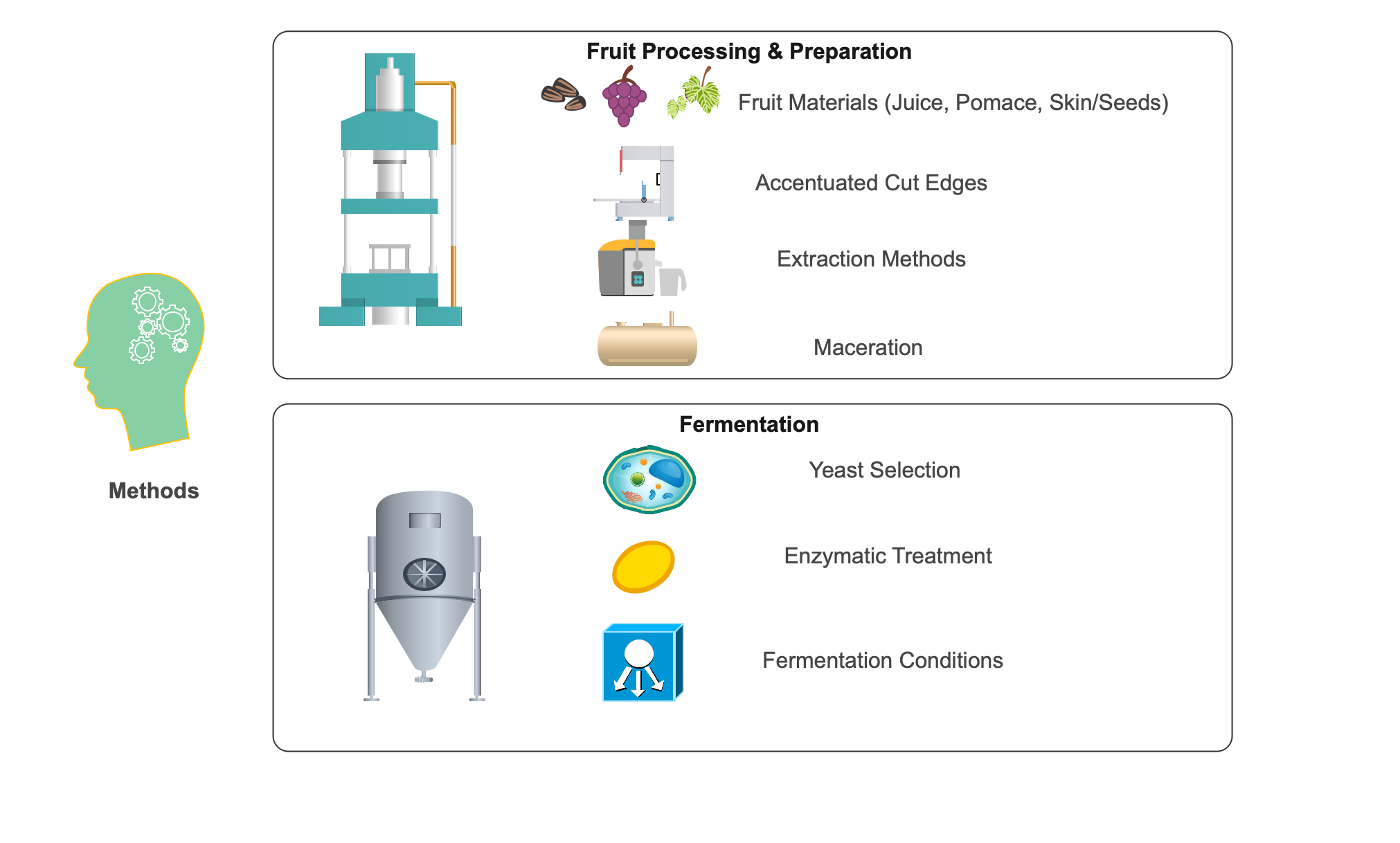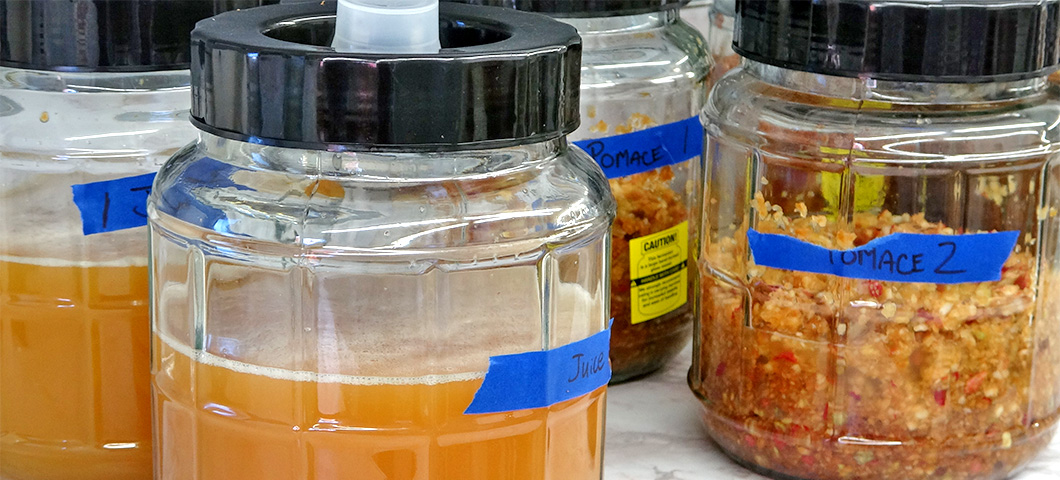Wine and Hard Cider Research
WARC is actively working on research to improve grape winemaking, hard apple cider and fruit winemaking to support the local wineries and cideries in MT. The general goal is to help craft beverage makers get the most flavor and profits out of MT-grown fruit. Research supported by USDA and Montana Department of Agriculture.
The purpose of this study:
1) Improve the quality and values of fermented products made from cold-hardy fruit with expanding cultivation in the state of Montana.
2) Increase profitability in wineries and cideries by finding optimal amount of fruit required and extract additional value by utilizing left-over fruit material, such as pomace and pulp.
In replicated research trials, we are evaluating various methods (Figure 1) for improving our local wine and cider including:
A. Fruit Processing & Preparation:
Strategies included:
-
- Adding value to the fruit material left-over after pressing (apple pomace and grape skins and seeds). This left-over fruit can still contain great flavor and be made into fermented products such as ciderkin and piquette.
- Juice extraction methods (steam juicer, juicer, wine press); Fruit preparation by Accentuated Cut Edges technique (fruits are run through a fruit mill/blender to mechanically cut into smaller fragments) and Maceration (soaking skins in juices).
- Figuring out the optimal dilution of fruit wines. While grape and apple juice has a good balance of sugar, acids, and flavor that allows it to be directly make into fermented products, many other fruits (e.g. cold hardy berries like Haskap/Honeyberry and Black Currant) are too acidic and low in sugar to make a balanced wine or cider. The fruit (juice or crushed fruit) are typically mixed with water and sugar to improve flavor, but little is known about what ratios give better color, aroma, and flavor.
- Types and varieties of fruit wines evaluated
B. Evaluating Fermentation Additions:
Different yeast strain impact on fermentation process and products; Enzymatic Treatment to improve clarity and enhance flavor or taste; Fermentation Condition Optimization.

Figure 1. Methods applied for WARC fermentation research.
The importance of this study:
-
Grapes:
Northern cool-climate grapes are relatively new and may require new approaches to make high-quality wines. The grapes and wines frequently contain excessive acid due to the short, cool growing season. We are working with wineries to refine recipes and methods for these new grape varieties.
-
Apples:
Local craft cideries are looking to branch out from traditional cider making methods to capture new consumers and trends and to deal with limited supplies of traditional cider apple varieties. They also want to get the most out of apple varieties that thrive in MT climates, including heirloom apple varieties.
-
Fruit wines:
Fruit wines produced from Montana adapted fruits like Haskap, Currants, Aronia, and Dwarf sour cherry are popular but have almost no research-based knowledge to improve and optimize current wine recipes. Research areas include how extract juice, how much fruit or juice to use in wine, supplemental enzyme utilization, or flavor optimization. Increasing customer preference toward products containing superfruits like Haskap, Currants, Aronia, Elderberry, and Cherry could increase the market for MT-grown fruit crops.
2022-2023 Research Summary
|
Fruits |
Varieties |
Treatment |
|
Grapes |
Frontenac gris |
Effects of running grapes through a fruit mill (Accentuated Cut Edges) and pre-ferment treatment (Hyper-oxidation) to improve clarity and flavor. |
|
Grapes |
Frontenac, Crimson Pearl, Verona, and Hasansky Sladky |
Evaluating effects of increasing sun-exposure on grapes (Fruit Zone Leaf Removal vs. Control) on wine qualities. |
|
Grapes |
La Crescent |
7 Yeast Strains |
|
Grapes |
Frontenac, La Crescent, Itasca, Prairie Star |
Piquette with Varying Red-White Pomace Ratios |
|
Apples |
Binet Rouge |
Binet Rouge cider must fermented with varying Non-Saccharomyces Yeasts |
|
Apples |
Binet Rouge |
Ciderkin: Pomace contact duration (1,5,9 days of ethanol fermentation). Purpose: find the optimal length of time to leave pomace in ferments to maximize flavor extraction. |
|
Apples |
Cortland (Pomace: Binet Rouge, Hewe's Virginia Crab) |
Base Cortland Cider with 5%,100%, or 30% Pomace additions from Cider varieties, Binet Rouge or Hewe’s Virginia Crab. The basic question here is can the left-over pomace from Cider-specific Apple varieties be used to improve ciders made from readily available, and somewhat bland, apples or base cider made from juice concentrate. |
|
Apples |
Hewe’s Virginia Crab |
Cider and ciderkin musts fermented following varying durations of pre-ethanolic fermentation exposure to Metschnikowia fructicola (a non-Saccharomyces yeast). |
|
Apples |
Macintosh |
+/- Pectinase; -> Direct or Pomace or Juice Fermentation |
|
Apples and Haskap |
Macintosh, 85-19 |
Base Macintosh apple cider produced via co-fermentation with varying quantities of haskap fruit (0%, 5%, 10%, 25%, 50%, 100%). |
|
Elderberry |
Samyl |
Effects of fruit preparation (Cooked/ Soaked 0 /Soaked 2 days- pouring hot water into and cool down) on wine quality |
|
Haskap Aronia |
Aurora (Juice from pressed); McKenzie (Puree) |
Same amount of haskap Juice 1.5 kg+ different amount of Aronia Puree (75g, 150g, 300g, 450g) |
|
Haskap |
Aurora |
Effects of Juicing methods followed by Fermentation (Steam Juicer; Juicer; Press) on juice and wine qualities. |
|
Haskap |
Aurora (Pressed) |
Haskap: Water different Volumn Ratio (1/1; 1/2; 1/4; 1/5) |
|
Blackcurrants |
Whistler (Blender Treated) |
Different Yeast Strains (non-Saccharomyces and Saccharomyces) |
Publication summaries
Exploring Yeast Strains in Blackcurrant Winemaking
Fermentation Process Effects on 'McIntosh' Apple Ciders
Apple and Grape Waste Pomace Fermentation and Co-Ferment Product Chemistry
Juice Dilution and Haskap Wine Quality
Influences of Processing Methods on Elderberry Wine Quality


